The Four Laws of LaRouche and Hamilton
by Jason Ross
November 2016
A PDF version of this article appears in the November 11, 2016 issue of Executive Intelligence Review and is re-published here with permission.
Adapted from a Friday, Nov. 4 LaRouchePAC webcast.
I’ve put together a few aids to thinking about what the implementation of LaRouche’s Four Laws looks like. In discussing that, I also want to think about this in terms of Hamilton. I’m very happy to say that Hamilton’s four great economic writings, along with the Four Laws of Lyndon LaRouche, will be available on Amazon very soon. It’s been submitted. It should only be a few more days. [Now available on Amazon as The Vision of Hamilton (Kindle edition).] I’ll be reading some quotes from this.
Let’s take a look at what an economic recovery would look like, using LaRouche’s Four Laws. Let me read what LaRouche said the remedy to the current situation is. LaRouche writes,
The only location for the immediately necessary action which could prevent such an immediate genocide throughout the trans-Atlantic sector of the planet, requires the U.S. government’s now immediate decision to institute four specific cardinal measures — measures which must be fully consistent with the specific intent of the original U.S. Federal Constitution, as had been specified by U.S. Treasury Secretary Alexander Hamilton while in office.
(1) Immediate re-enactment of the Glass-Steagall Law, instituted by U.S. President Franklin D. Roosevelt, without modification as to principle of action.
(2) A return to a system of top-down, thoroughly defined national banking.”
Skipping ahead:
“(3) The purpose of the use of a federal credit system, is to generate high productivity trends in improvements in employment, with the accompanying intention to increase the physical economic productivity and standard of living of the persons and households of the United States.”
And (4), LaRouche writes,
“Adopt a fusion-driver ‘crash program.’ The essential distinction of man from all lower forms of life, is that it presents the means for the perfection of the specifically affirmative aims and needs of the human individual and social life."
Let’s take a look through some of these Four Laws. The first step is Glass-Steagall, which I’ll just say a little bit about. This is something we’ve discussed frequently and to great effect, I think, in our programs and on our website.
Figure 1
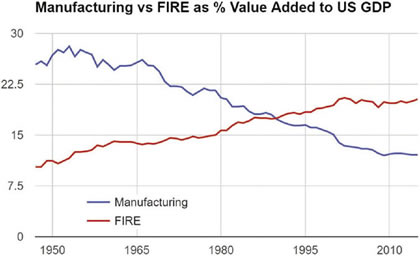 View full size |
Take a look here. [Figure 1] This is what percent of supposed U.S. income, what percent of the value added in our GDP, comes from manufacturing—you see that there in blue—vs. “F.I.R.E.,” which stands for finance, insurance, and real estate. For over 30 years now, the world of finance itself has supposedly, according to official thinking, contributed as much to U.S. productivity and economy, as has manufacturing. Flipping houses —that kind of thing—is now as productive as manufacturing steel, or building things. It’s crazy!
Over this period, [Figure 2]—this is Lyndon LaRouche’s Triple Curve, a pedagogical device that he had used to describe the increase in monetary and financial aggregates, at the same time that the physical economic output of the economy was collapsing—we’ve been in this situation for decades now.
|
Figure 2
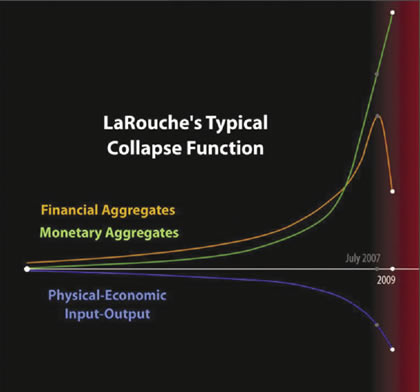 View full size |
What we need to do, then, is make it possible to be able to finance a recovery. Alexander Hamilton, in his reports on public credit and the national bank and on its constitutionality, describes the importance of banking. Banks can provide an essential function for the economy. They’re not optional. They provide an essential useful function. Now, they’re tied up, in a way, where the potential of the banking sector is impossible right now, because they’re involved in all sorts of speculation and gambling. By implementing Glass-Steagall, we make it possible for the banking sector to be able to play that useful role, while jailing and shutting down all of the people behind the collapse that’s been created and the looting that’s been taking place via Wall Street.
We’ve got a lot of very good recent additions to our website. The Economics Frequently Asked Questions page addresses some of these questions that come up that you may have heard when talking to people about these things. For example: “If Glass-Steagall were still law, it wouldn’t have stopped the crash of 2007-8.” Are you sick of hearing that? Well, you can now just send people the explanations here. You don’t really need to waste your time with it. It’s very clear.
National Banking
So, Glass-Steagall’s the first step. Step two that Mr. LaRouche describes is national banking. This is definitely a more complex concept. I direct people again, to the works of Alexander Hamilton on this, to get a sense from the beginning, of what it meant to have a national bank, or the role that banking could play in the nation. I’d point to the success of this approach under the administrations of Washington and Hamilton, of John Quincy Adams, of Lincoln, and of Franklin Roosevelt, who, in various ways, created the effect, if not the form, of national banking, through a facility for the promotion of credit and directing it in an economy.
One of the most horrific ideas that people have about how economics works, is that you shouldn’t try to direct anything; that government should always stay out; that the “invisible hand” does everything in the best possible way. This is something that Hamilton addresses very directly, countering the arguments of Adam Smith’s Wealth of Nations, for example, in these reports.
Once we decide that we’re going to have a national orientation, and actually choose a direction to go, the question then, is how do we direct this credit in the direction of programs that are going to increase the energy-flux density? How then do we understand “energy-flux density?” This is an economics concept that Mr. LaRouche has employed over the years in his understanding of economy.
Figure 3
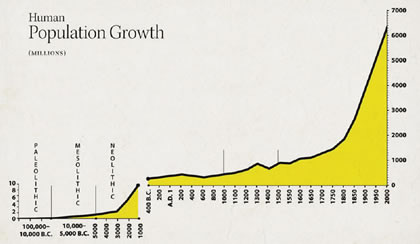 View full size |
We have to think about what is the basis of the transformation of the human species, over time, in a way that’s uncharacteristic of any other form of life. This chart of “Population Growth Over the Historical Time Period” [Figure 3] is of human population growth. It couldn’t have been the growth of any animal species acting on its own. Animal species don’t transform their relationship to nature. They can’t discover principles. They might use a tool, like a stick, to do something, or a rock. They don’t use principles as tools.
The beginning of this, the real starting point for this for us historically, certainly in Europe, or extended European civilization, is Prometheus, the Greek story of Prometheus—who really created humanity. Before Prometheus, who, as the story goes, took fire from heaven and gave it to mankind—human beings were animals. Prometheus describes that when he saw mankind, we were just animals. We had eyes to see (but we didn’t understand); we had ears, but we didn’t understand anything. We lived like swarming ants. What did Prometheus do? He brought fire; he brought astronomy; he brought navigation; he brought beasts of burden; he brought sailing; he brought agriculture; he brought the calendar; he brought poetry; and he brought written language, mathematics, science, knowledge, and fire. What defines us as a species, as in this original story of the creation of the specifically human species, is this power of fire.
Figure 4
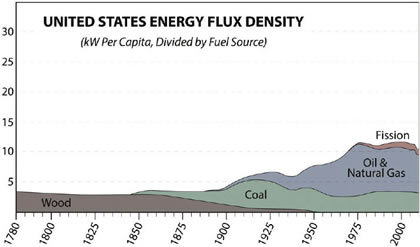 View full size |
We now consider the different kinds of fire that have been developed over historical time. Take a look at this [Figure 4]. This is the use of different forms of energy over the history of the United States. Two trends we can see here: (1) the energy used per person has, overall, increased—although not at a uniform rate. It’s not increasing now. The other thing that we can notice, is that (2) the type of fuel used has changed over time. Wood has very niche applications at present as a fuel. Wood is used for furniture, not for burning. Coal replaced the use of wood, saving forests by making it possible to not have to cut down all sorts of trees to make metals by making charcoal out of the wood. Oil and natural gas supplanted the use of coal. Nuclear fission—which never reached its full potential—in this projection, from the era of the Kennedy administration, was expected to become a primary, dominant form of power for the United States, and, indeed, as seen, for the world.
The New Silk Road
What this shows us, is, yes, using more energy. The other thing is the type of energy. What can you do with that energy? Think about what you can do with oil and natural gas that you can’t do with coal or wood. You can’t run a car with wood. You can’t run a car with coal. You can run a car on oil. You can’t run a train on wood! You can run a train on coal. What can we do with nuclear power that we can’t do with lower forms? Think about how with coal, we can use wood for furniture instead of for burning. Oil: that’s what we make plastic out of. Oil is a useful substance. It’s a wonderful material. It’s a great source of carbon, which, by its chemical nature, is able to form enormous molecules. Here it is, sitting in the ground, ready to be used to make all sorts of products, and we’re burning it! It’s, you know, it’s stupid!
With the potential that we’ve got of shifting to a real nuclear economy, of developing fusion, we would be reaching another stage of energy-flux density. What’s the power, the throughput power of your energy source? And what qualitative improvements does it bring? What new things does it allow you to do?
Figure 5
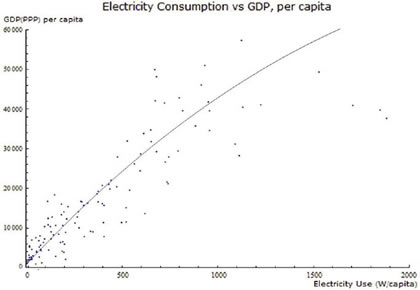 View full size |
You can’t have economic development without power, without energy. Here’s a chart [Figure 5] of electricity use per capita vs. GDP per capita. I know GDP per capita is not the best measure, but it’s very clear what you see with these things. If you say, which parts of the world seen here are relatively wealthy and have higher living standards and life expectancies? Well, it’s the places where you see the most light. The places where it’s dark, that’s not because people are people are fond of astronomy in that region and keep their lights off at night so that they can see the stars better. It’s because there’s not development.
Infrastructure itself really serves as the mediator, the great mediator, of higher forms of energy-flux density into the economy as a whole—the mediator of bringing new technologies into achieving a maximal expression in the economy, by partaking in almost all of the processes that go on in an economy.
Figure 6
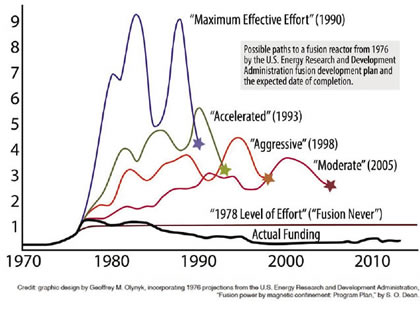 View full size |
We now consider the fourth of Mr. LaRouche’s Four Laws, which is the call for a crash program on nuclear fusion. This [Figure 6] is a chart that was created back in 1976. What this chart showed was, based on how much money was devoted to achieving the fusion breakthrough, at what year it was anticipated that the great breakthrough for a commercial fusion reactor would take place. In ’76 it was considered that if a maximum possible effort were put into this—something on the scale of the Manhattan Project, or the Apollo Project to go to the Moon—if we took that approach with fusion, it was anticipated that we would have had it over 25 years ago! Even at a moderate level of funding, we should have had it a decade ago, according to this projection, which isn’t necessarily exactly right. Actual funding for fusion has been below the level that was anticipated in the ’70s to never achieve fusion. In other words, there has been a decision not to reach the next level of Promethean fire, not to make that breakthrough on fusion.
Why would that happen? Who would hold back the development of fusion power? Is it the oil industry trying to make money selling more oil? No; that is far too simplistic. It is the brutish outlook of the British Empire, of Zeus earlier—Zeus, the character from the Prometheus story. Zeus, the tyrannical god who created his own power in part by holding back others. Preventing mankind from making this step, is one of the greatest crimes that has ever been committed; the deliberate underfunding of fusion and the campaign to prevent its development.
I don’t want to go on forever; let me just show a few projects that the United States ought to participate in with a sane outlook. There’s a different paradigm going on in the world right now, with the BRICS highly representing this; it represents the decades of work by LaRouche and the LaRouche movement organizing for this World Land-Bridge proposal, something that’s been promoted for decades now. This proposal, the power of this idea to change the world, is absolutely being realized at present. This concept that Lyndon and Helga LaRouche have been organizing for, is now Chinese policy; the “One Belt, One Road” program that is now bringing together over 70 nations representing the majority of the world’s population. The greatest potential for economic growth in the world; this is a policy that is taking place.
What the U.S.A. Could Be
Figure 7
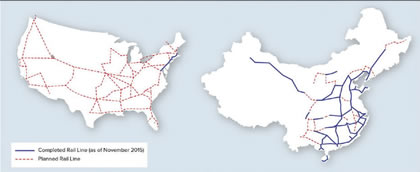 View full size |
Instead, the United States under Obama—who should be thrown out of office yesterday, if not last week, last month, last year; those would all be even better—is holding these things back. What would it look like if we joined? One thing would be the Bering Strait crossing, a proposal that was first discussed over a century ago. Really bringing the United States, via land, into coordination and connection with Eurasia and Africa, with the rest of the world in a very serious way, a new way and a more efficient way than sea-borne shipping. Within the United States, we’ve got [Figure 7] to test your geography here, this is the United States on the left, and on the right that is China. Similar nations in size. Look at all that high-speed rail in China that you see in blue, and probably some of the red; since this map was made, they’ve probably completed it, they’re building it so rapidly. The United States doesn’t have a high-speed rail network; we barely have a rail network. Instead, we use the less-efficient form of road transportation for freight and for people stuck in traffic jams. What would it mean to build a network that makes the United States more efficient, more productive? How many jobs would be involved in building new cities, in building the kinds of power plants that would be required? What kind of power could we have over our physical economy with the really full development of control over the water cycle? It is within our means to create desalination right now in California to provide for coastal water needs if we wanted to do that. It’s within our ability to do serious and in-depth research on atmospheric ionization and other technologies to control the water cycle. It’s within our ability to transfer water that has already fallen on land; but we need to ensure that there’s actually enough to make that a possibility.
So, let me read a couple of quotes from Alexander Hamilton here, in terms of where an understanding of an increase in energy flux density, of where economic growth comes from. It doesn’t come from money; it comes from the human mind. Here’s Treasury Secretary Hamilton. He’s describing in the beginning of his “Report on Manufactures” whether it makes sense to have a manufacturing economy, as opposed to a purely agricultural one, which today seems like a stupid argument to even have, but it was something that Thomas Jefferson didn’t get, for example. Because he wanted to keep the American economy from developing; he didn’t have that same outlook on human beings—clearly—that Alexander Hamilton did.
So, Hamilton writes that “the work of artificers as opposed to cultivators,” that is, manufacturing as opposed to farming, “is susceptible of a greater improvement in a proportionately greater degree of improvement of its productive powers; whether by the accession of skill, or from the application of ingenious machinery”—labor saving machinery. How does the development of a new technology transform the potential of production in an economy? This is a quote Matt had used: Hamilton writes—on page 148 when you get the book—“It merits particular observation that the multiplication of manufactories not only furnishes a market for those articles which have been accustomed to be produced in abundance in a country, but it likewise creates a demand for such as were either unknown or produced in inconsiderable quantities. The bowels as well as the surface of the Earth are ransacked for articles which were before neglected. Animals, plants, and minerals acquire a utility and value which were before unexplored.” Iron ore wasn’t iron ore before the Iron Age; it was a rock. Malachite wasn’t copper ore before the Bronze Age; it was just a green rock that Egyptians used for mascara. You transform the value of the things around you; the mind transforms what those things are. That rock was transformed into ore by the human mind. We change the universe through our discoveries; we transform our relationship to it, we change what it is, what it can participate in.
Hamilton understood that the purpose of the United States was nothing less than the promotion of the General Welfare. This quote is a bit long to read, but it’s on page 187; and it’s where he describes that there shouldn’t be a limitation—except what comes up in the Constitution—against government action to promote the General Welfare. He says “the term General Welfare, doubtless intended to signify more than was expressed or imported in those parts of the Constitution and Congress’ powers which preceded it. This phrase is as comprehensive as any that could have been used, because it was not fit that the Constitutional authority of the Union to appropriate its revenues should have been restricted within narrower limits than the General Welfare.” The real point to take is that it’s a different economic outlook. What China is doing is great, but it’s not up to the level of what it should be. The concept embodied in the One Belt, One Road project is positive; it’s very good. But what really needs to be brought to this, is the explicit understanding of its basis in the human identity. The human ability to make discoveries that transform our relationship to Nature; that’s the key to economics. We see its effects in various studies we might do about how building a road transforms the amount of agricultural production in an area; or how bringing in a stable power supply allows factories not to have to turn off every three hours when the power goes out—what transformations that makes. But the real key is to give a mission to people, by participation in the ability to bring that to a yet higher level of understanding, of living standards, and of participation in that process. That’s the key thing; to create a society where people are able to participate knowingly in that increase.
